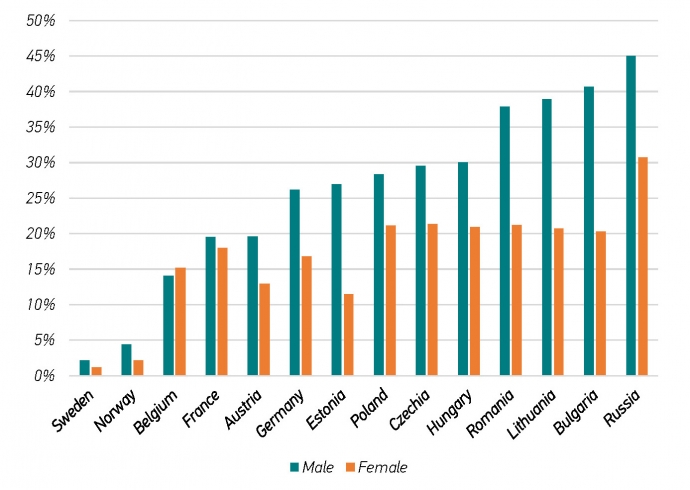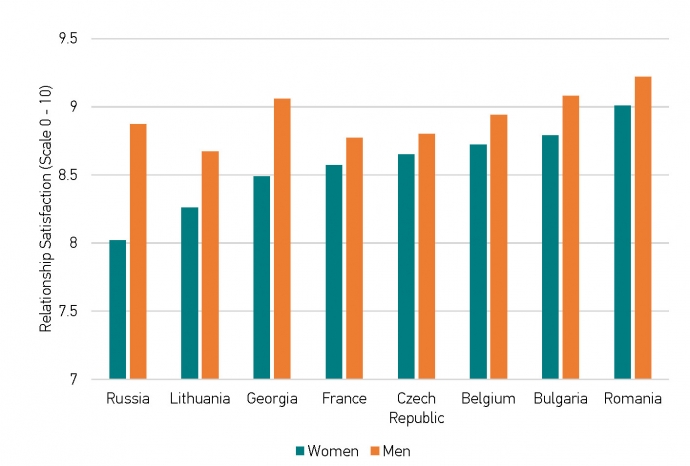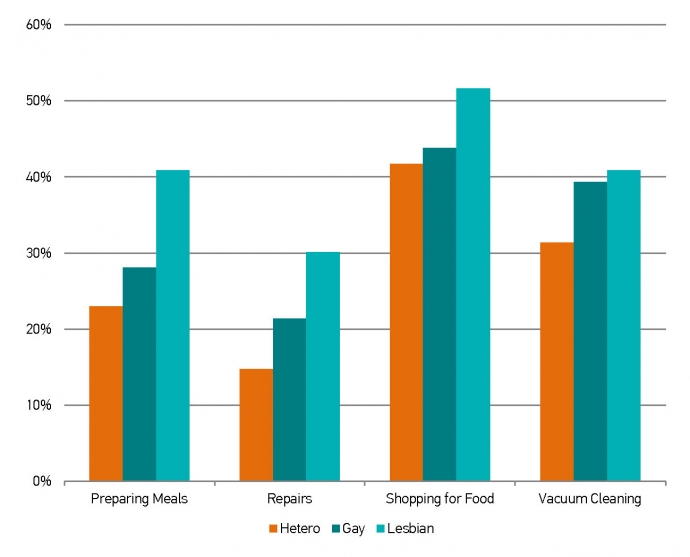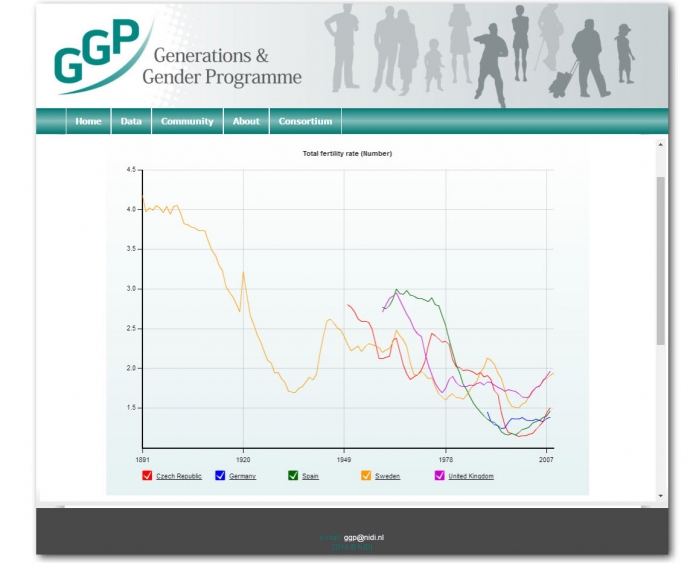Migration can have profound consequences for family solidarity: when adult children leave the country of origin, ageing parents are deprived of potential care and support. This is especially disruptive in societies where families play an indispensable role in care and welfare provisions, as is the case in Eastern Europe. A comparison of the migrant population to the origin and destination populations gives a hint as to whether migrants adapt to the host country or they preserve their heritage. Figure 1 shows that Poles living in Poland strongly abide by family obligation norms—more than 80% of respondents, regardless of gender, agree that children should take responsibility for caring for their parents when parents are in need. In the Netherlands, the support for this statement was lower—43%, with females showing less support than males. In comparison, Polish migrants’ support for filial obligation is more in line with what is observed in Poland, although it is slightly lower (72%, no gender difference). This result could point towards a selection effect, with less traditional individuals being more likely to leave the country. Nevertheless, Polish migrants seem to maintain the traditional model of family ties existing in Poland.
Support for filial norms in the Netherlands, Poland and amongst Poles in the Netherlands

Generations and Gender Survey, Wave 1 for the Netherlands and Poland, FPN study for Polish migrants, Wave 1 for Polish migrants in the Netherlands. Note: Population aged 18-59 years old who either agree or strongly agree with the statement that “Children should take responsibility for caring for their parents when parents are in need”
Migration can have profound consequences for family solidarity: when adult children leave the country of origin, ageing parents are deprived of potential care and support. This is especially disruptive in societies where families play an indispensable role in care and welfare provisions, as is the case in Eastern Europe. A comparison of the migrant population to the origin and destination populations gives a hint as to whether migrants adapt to the host country or they preserve their heritage. Figure 1 shows that Poles living in Poland strongly abide by family obligation norms—more than 80% of respondents, regardless of gender, agree that children should take responsibility for caring for their parents when parents are in need. In the Netherlands, the support for this statement was lower—43%, with females showing less support than males. In comparison, Polish migrants’ support for filial obligation is more in line with what is observed in Poland, although it is slightly lower (72%, no gender difference). This result could point towards a selection effect, with less traditional individuals being more likely to leave the country. Nevertheless, Polish migrants seem to maintain the traditional model of family ties existing in Poland.
Support for filial norms in the Netherlands, Poland and amongst Poles in the Netherlands

Generations and Gender Survey, Wave 1 for the Netherlands and Poland, FPN study for Polish migrants, Wave 1 for Polish migrants in the Netherlands. Note: Population aged 18-59 years old who either agree or strongly agree with the statement that “Children should take responsibility for caring for their parents when parents are in need”
Gender equality varies considerably across Europe. In many countries, there is still a strong belief intraditional gender roles as can be seen from the figure below. In Central and Eastern Europe, thereis still a large proportion of the population that believes men shoud be prioritised for jobs when thereis a scarcity of work. This is in stark contrast to Scandinavia and Western Europe where such viewsare much less common. The big difference between countries such as France and Bulgaria howeveris in the views of men and not women. In France, 18% of women believe men should get priority forjobs when work is scarce and in Bulgaria it is only a little higher at 20%. However when we look at thesame figures for men they are 19% and 41% respectively. This would suggest that the biggest differencebetween Western Europe and Eastern Europe is men’s attitudes towards gender equality. The largedifference in attitudes between men and women in Eastern Europe could also be causing very differentexpectations about family life, careers and relationships as men seek traditional arrangements whilstwomen seek gender equality.
The percentage who agree with the statement that “When Jobs are scarce, men should have more right to a job than women”

Generations and Gender Survey, Wave 1. Population aged 18-79 years old who either agree or strongly agree with the statement that “when jobs are scarce, men should hve more right to a job than women”
Relationship satisfaction is a key indicator in the GGS. It has been shown to be highly predictive of future break ups and highly correlated with other indicators of well-being. Understanding what makes for a satisfying relationship, and what policy makers could possibly do to help, is possible using data from the GGS. In their paper to be presented at the European Population Conference in Mainz, Van Damme and Dykstra examine how gender equality within a couple shapes their relationship satisfaction, and the degree to which gender equality within wider society might affect this. Their results suggest that women are less satisfied when they have more resources, in terms of education, relative to their partner. Conversely, when their resources are measured in absolute terms, women with more education and occupational status are more satisfied with their relationships. When looking at the social context, the results suggest that women in more egalitarian societies are more satisfied with their relationships. The full results of the analysis will be presented by the authors in Session 73 in Room P 101 at 11am on Friday 2nd September.
Figure 1: The average relationship satisfaction of individuals in couples (Scale of 0 to 10)

Van Damme & Dykstra (2016) “Relative resources and marital instability: a comparison of eightEuropean countries”, Session 73. Families and gender
The large sample sizes of the Generations anfd Gender Survey allow researchers to understand how various minority groups might differ in some of their behaviour from the rest of the population. One such group that is well covered and relevant to the work of the GGP is same-sex couples. With the increasing prevelance of same sex marriage across the world, it is important for both social scientists and policy makers to understand how these couples compare to other couples. Below we see the proportion of couples that divide various household tasks equally, broken down by sexual orientation of the couple. What is clear is that same-sex couples tend to be more egalitarian in the distribution of tasks compared to heterosexual couples. The difference does however differ depending on the task.
Figure 1: The percentage of couples who share specific household tasks equally by sexuality

Bauer, G. (2016). Gender Roles, Comparative Advantages and the Life Course: The Division of Domestic Labor in Same-Sex and Different-Sex Couples. European Journal of Population, 32(1), 99-128. Note: The empirical analysis is based upon the Generations and Gender Survey from Austria, Belgium, France, the Netherlands, Norway, Sweden and Australia.
The Generations and Gender Programme provides contextual data for use alongside its survey data. These are held in the Contextual Database (CDB) and the Contextual Data Collection (CDC). The CDB provides 74 indicators for more than 60 countries. Beyond providing data that facilitate multilevel modelling, the CDB also represents a useful resource for alternative approaches that aim to account for contextual conditions, or for macro-level investigations: e.g., fixed-effects models, geoadditive and geostatistical approaches, fuzzy-set analyses, (agent-based) simulations, and time-series analyses. The CDC provides data on the countries covered by the GGS including approximately 253 indicators . Among these indicators are around 127 national-level time series, 67 sub-national regional variables, and 59 policy histories that contain standardised descriptions of policy reforms. The information dates back to the 1970s so that it can be used in combination with the life histories collected in the GGS. This data is freely available and ready for download via the GGP website.
The GGP Contextual Database Interface

Fill the form below with your contact information to receive our monthly GGP at a glance newsletter.
